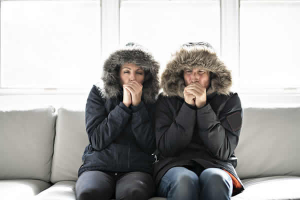
14 Jan, 2021
All regular thermostats have a special setting labeled “EM heat.” But what is it? Many people falsely assuming it’s a setting for you to switch on during freezing temperatures. However, this isn’t true. “EM” stands for emergency, and this secondary heating system is a back-up to keep your house warm when your primary heat fails. So, you don’t want to go switching it on without knowing what you’re doing.
No matter the circumstance, you should understand your home appliances’ settings before you mess with them. That’s why we’ve created this guide on EM Heat, so you know the appropriate way to use a heat pump in your home.
What is EM heat on thermostat settings? Short for “emergency heat,” it is a setting that controls your home’s back-up heating system. If you have an emergency heat thermostat setting, you likely have a heat pump, as well as a gas, oil, electric, or hot-water back-up system.
Most systems have a heat pump as its primary setting and activate their secondary (gas, oil, or electric) heating when supplemental, or second-stage, heating is required. In colder climates (below 35° Fahrenheit), all heat pumps need a secondary heating source because your heater taps into this setting when outside temperatures drop too low.
However, if you turn on your EM heat manually, you begin drawing heat only from the secondary source. Now, instead of working with your main heat pump, your backup is working solo. This is way less efficient than your primary heating system, so you should only use it in real emergencies unless you want to pay exorbitant heating bills.
As we mentioned above, homes with heat pumps come with a two-part system: the heat pump and the auxiliary heating source. The primary heat pump is usually located outside of the house, while the second stage heating source is inside.
The second heating stage is designed to be a supplemental source of heat when the temperature is too low for your heat pump to extract heat from the outside. Different systems and thermostats have different methods of determining when to activate this secondary source. Typically, this secondary heat source is automatically triggered when temperatures are below the set threshold.
Additionally, the heat pump, which is outside on most houses, collects frost on the coils. When the heat pumps turn off temporarily to defrost the unit, this secondary source kicks in automatically. As a result, it is not necessary to switch to the EM heat setting yourself. Your thermostat will indicate when the setting is on, usually with a light.
While this secondary system is automatic (and mostly used in accordance with your primary heating system), you can turn it on manually. This is when it's referred to as “EM heat.” When you turn on your EM heat, you’re telling your heating system to stop using your heat pump and only use this supplemental source.
Many homeowners are unsure when to use emergency heat, but it’s simple: emergency heat is meant for just that, emergencies.
While some people believe that is a setting for extra-cold days when they need some added warmth, they’ll be sad when they get their heating bill (and they won’t be any warmer.) As mentioned before, when temperatures dip too low, your home’s heating system will automatically activate your backup heating system to work with your primary system.
So when should you turn on your EM heat? The only time that you should activate emergency heating is if your heat pump is broken. Also, you should only use it temporarily until you can get your heating system fixed.
If you notice that your heating system is not keeping your home warm or that the heat pump has been damaged, you may need to get a repair, and you can turn on your EM heat. Or, if your primary heat pump is frozen and will not defrost despite your heater being on, you can activate your emergency heat as you wait for a qualified service technician to take a look at it.
If you’ve accidentally turned on your EM heat and you’re frantically Googling “how to turn off emergency heat,” don’t worry. Just like turning it on, you can deactivate your emergency heat with the switch.
In normal mode, a heat pump works by pulling in heat from the outside. The heat pump setting’s emergency heat will usually switch on and off automatically during brief periods when the outside air gets too cold. Your heating system will then use the secondary system with your normal heating. However, if your heat pump constantly switches to back-up heat, even in mild temperatures, this indicates a problem, and a technician should check it out.
On the other hand, manually activating your EM heat sets up a different chain of events. The system will bypass the main heat pump and be forced into auxiliary mode. It then relies solely on the backup heat source to generate heat, only using the indoor unit as a source of heat. Where does emergency heat come from? This could be a backup gas furnace, an electric heat strip, oil, or a hot-water system. If your EM heat is electric, you can expect much higher prices when running your EM system.
Because EM Heat uses far more energy than a properly functioning heat pump-based system, the EM heat setting’s long-term use would be quite expensive and should be avoided. This is because backup systems, such as an electric strip or gas furnace, are less efficient at pulling heat. The electric strip runs on electricity and is especially notorious for increasing your bill.
Avoid having to switch to EM heating on your system with proper maintenance and swift repairs. Valley Service is your Fargo, North Dakota home comfort expert! We’re specialists in heating, air conditioning, air quality, and plumbing. Call us today to book one of our HVAC technicians or furnace repair services or send us a message, and we’ll get back to you soon.